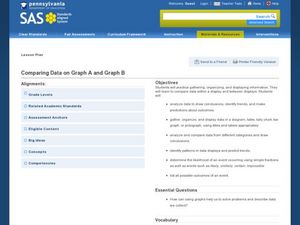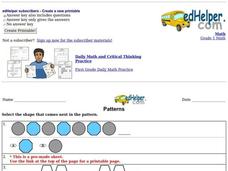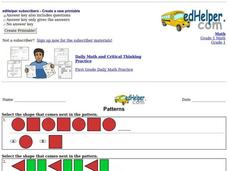Curated OER
Lesson Plan One: Points, Lines, Rays
Fifth graders explore basic geometric terms. Pupils draw a physical picture of a scene that illustrates at least five geometric terms. Partners exchange drawings and locate the illustration of geometric terms in the drawing.
Curated OER
Comparing Data on Graph A and Graph B
Second graders gather and graph data. In this graphing lesson plan, 2nd graders collect data and graph this information using tally charts, bar graphs, pictographs, or tables. They make predictions about the outcomes.
Curated OER
License Plate Investigation
In this license plate investigation worksheet, 6th graders identify and complete 6 different word problems related to auto license plates. First, they complete the chart showing the number of combinations possible based on the license...
Curated OER
Uses of Numbers
For this uses of numbers worksheet, students complete nine fill in the blank questions where they describe the use of each given number as position, count, measure, or label. Next students complete 6 number patterns using both counting...
Curated OER
Tall Tale Rollers
Students explore American tall tales. In this tall tale lesson, students discover the six characteristics that are included in tall tales. Students survey their class to find each student's favorite tall tale character and organize the...
Curated OER
Solving a Legend- Exponents, Recursive and Explicit Equations.
Eighth graders play a game to solve problems. In this exponents and scientific notations lesson, 8th graders play a game in small groups to move colored disks from location A to location C. Students identify recursive patterns to solve...
Curated OER
Number Scrolls
Students write the number line. In this numbers lesson, students write numbers in numeric order on a number scroll. They find patterns within this number line.
Curated OER
Interpreting Data
In this interpreting data worksheet, students solve and complete 4 different types of problems using different data types. First, they collect raw data from a paragraph shown. Then, students identify the examples of two different types...
Curated OER
The Little House
First graders read the story "The Little House" and discuss changing patterns and then create a seasonal mandala using a paper plate and crayons.
Curated OER
Guess That Sequence!
Students analyze number sense by participating in a pattern identification activity. In this number sequence lesson, students examine several groups of numbers and identify the sequence in the group before adding on to it. Students check...
Curated OER
You Must Know These
In this sequence worksheet, students compute the value of the nth term. They identify a convergent series. This one-page worksheet contains four problems.
Curated OER
What Comes First?
In this numeral learning exercise, students identify counting numbers one through ten and place them in sequential order. There are ten problems listed on this learning exercise. Students demonstrate their knowledge to count from one...
Houghton Mifflin Harcourt
Fraction Strips
Identify, compare, and order fractions with a hands-on learning tool. Fraction strips are a great way to help young mathematicians understand and visualize fraction values. The worksheet can be made into an activity in which pupils cut...
Mathematics Vision Project
Geometric Figures
Logical thinking is at the forefront of this jam-packed lesson, with young mathematicians not only investigating geometric concepts but also how they "know what they know". Through each activity and worksheet, learners wrestle with...
PBS
Working with Coordinate Planes: Activities and Supplemental Materials
Seven activities make up a collection of supplemental materials to reinforce graphing on a coordinate plane. Worksheet objectives include plotting coordinates within single and four quadrants, measuring straight and diagonal lines, and...
EngageNY
Factoring Extended to the Complex Realm
A solution will work one way or another: find solutions, or use solutions to find the function. Learners use polynomial identities to factor polynomials with complex solutions. They then use solutions and the Zero Product Property to...
EngageNY
Logarithms—How Many Digits Do You Need?
Forget your ID number? Your pupils learn to use logarithms to determine the number of digits or characters necessary to create individual ID numbers for all members of a group.
Curated OER
Beep, Beep, Vroom, Vroom
Students practice identifying, creating and labeling simple patterns. They recreate patterns in used in Stuart Murphy's book, Beep, Beep, Vroom, Vroom.
Curated OER
Make-Your-Own Math Practice
Students create their own math practice book. In these homemade book lessons, students create their own counting, number, and shape pages. When the pages are complete, they are bound together in a book.
EdHelper
Patterns
In this shape patterns activity, 1st graders identify the shapes in the 5 problems and select the shape that continues each pattern.
Curated OER
Patterns
In this shape patterns instructional activity, 1st graders identify the shapes in the 5 problems and select the shape that continues each pattern.
EdHelper
Patterns
In this shape patterns worksheet, students identify the shapes in the 3 problems and select the shape that continues the pattern.
EdHelper
Patterns
In this shape patterns activity, students identify the shapes in the 21 problems and select the shape that continues the pattern.
EdHelper
Patterns
For this shape patterns activity, students draw identify the shapes in each set and draw the missing shape to complete the 11 patterns.

























